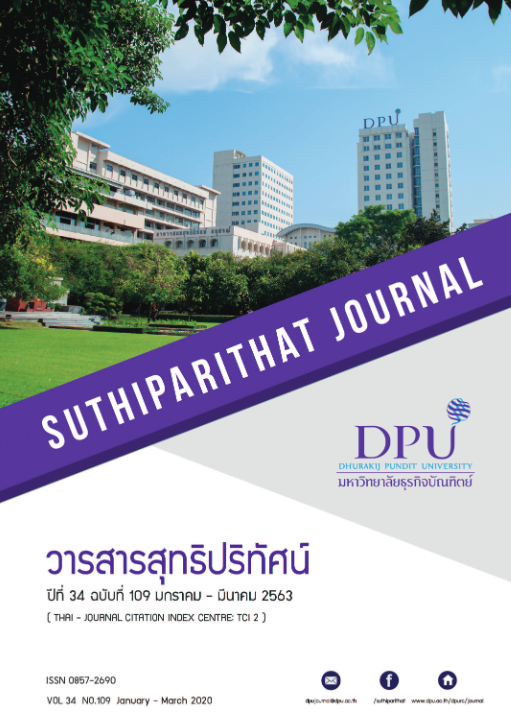การวิเคราะห์องค์ประกอบเชิงยืนยันภาวะผู้นำการเปลี่ยนแปลงของพนักงานในสถานประกอบการวิสาหกิจขนาดกลางและขนาดย่อม (ภาคการผลิต) เขตภาคตะวันออกเฉียงเหนือตอนล่าง 2
คำสำคัญ:
องค์ประกอบเชิงยืนยัน, ภาวะผู้นำการเปลี่ยนแปลง, วิสาหกิจขนาดกลางและขนาดย่อมบทคัดย่อ
งานวิจัยนี้มีจุดมุ่งหมายเพื่อศึกษาภาวะผู้นำการเปลี่ยนแปลงของพนักงานในสถานประกอบการวิสาหกิจขนาดกลางและขนาดย่อม (ภาคการผลิต) เขตภาคตะวันออกเฉียงเหนือตอนล่าง 2 และวิเคราะห์องค์ประกอบเชิงยืนยันของภาวะผู้นำการเปลี่ยนแปลงของพนักงานในสถานประกอบการวิสาหกิจขนาดกลางและขนาดย่อม (ภาคการผลิต) เขตภาคตะวันออกเฉียงเหนือตอนล่าง 2 รวมทั้งตรวจสอบความสอดคล้องระหว่างโครงสร้างองค์ประกอบภาวะผู้นำการเปลี่ยนแปลงของพนักงานในสถานประกอบการวิสาหกิจ ขนาดกลางและขนาดย่อม (ภาคการผลิต) เขตภาคตะวันออกเฉียงเหนือตอนล่าง 2 กับข้อมูลเชิงประจักษ์ โดยมีกลุ่มตัวอย่างคือ พนักงานในสถานประกอบการวิสาหกิจขนาดกลางและขนาดย่อม (ภาคการผลิต) เขตภาคตะวันออกเฉียงเหนือตอนล่าง 2 จำนวน 611 ตัวอย่าง ใช้แบบสอบถามเป็นเครื่องมือเก็บข้อมูล วิเคราะห์ข้อมูลด้วยสถิติเชิงพรรณนาและการวิเคราะห์องค์ประกอบเชิงยืนยัน ผลการวิจัยพบว่า ภาวะผู้นำการเปลี่ยนแปลงของของพนักงานในสถานประกอบการวิสาหกิจขนาดกลางและขนาดย่อม (ภาคการผลิต) เขตภาคตะวันออกเฉียงเหนือตอนล่าง 2 อยู่ในระดับมาก โดยองค์ประกอบของภาวะผู้นำการเปลี่ยนแปลง มี 2 องค์ประกอบ คือ องค์ประกอบการกระตุ้นแรงบันดาลใจและการเอาใจใส่และองค์ประกอบการมีอุดมการณ์ด้านทัศนคติและพฤติกรรม ผลการวิเคราะห์องค์ประกอบเชิงยืนยันลำดับสองพบว่าโมเดลมีความสอดคล้องกับข้อมูลเชิงประจักษ์
เอกสารอ้างอิง
เกษศิริ โมรา. (2557). แบบจำลองความสัมพันธ์เชิงสาเหตุของพฤติกรรมการเป็นพนักงานที่ดีของกิจการโทรคมนาคม (ปริญญานิพนธ์ปริญญาดุษฎีบัณฑิต). กรุงเทพฯ: มหาวิทยาลัยนอร์ทกรุงเทพ.
คณะกรรมการพัฒนาการเศรษฐกิจและสังคมแห่งชาติ, สำนักงาน. (2560). รายงานประจำปี 2559. กรุงเทพฯ: สำนักงานคณะกรรมการพัฒนาการเศรษฐกิจและสังคมแห่งชาติ.
พิริยะ ผลพิรุฬห์. (2556). บทบาทของวิสาหกิจขนาดกลางและขนาดย่อมไทยในระบบเศรษฐกิจสร้างสรรค์. วารสารพัฒนาการเศรษฐกิจปริทรรศน์, 7(1), 205.
โรงงานอุตสาหกรรม กระทรวงอุตสาหกรรม, กรม. (2559). รายงานสถิติจำนวนโรงงานอุตสาหกรรมของกลุ่มจังหวัดภาคตะวันออกเฉียงเหนือตอนล่าง 2. สืบค้น 22 กรกฎาคม 2559, จาก https://www.diw.go.th/thawk/content.php?modespss59
Alminitisir, A. B., Akeel, A. B. & Subramaniam, I. D. (2013). The role of transformation leadership style in motivating public sector employees in Libya. Australian Journal of Basic and Applied Sciences, 7(2), 99-108.
Antonakis, J. (2012). Transformational and charismatic leadership. Thousand Oaks: Sage Publications.
Bass, B. M., & Avolio, B. J. (1994). Shatter the glass ceiling: Women may make better managers. Human Resource Management, 33, 549-560.
Burns, J. M. (1978). Leadership. New York: Harper and Row.
Bushra, F., Usman, A., & Naveed, A. (2011). Effect of transformational leadership on employees’ job satisfaction and organizational commitment in banking sector of Lahore (Pakistan). International Journal of Business and Social Science, 2(18), 261-267.
Church, D. M. (2012). Leadership style and organizational growth: A correlational study (Doctor dissertation). USA: University of Colorado.
Green, W. L. (2014). Empirical correlation among transactional, transformational and laissez-faire leadership: Comparisons, arguments, and relationship with perceived leadership style. Pro-Quest Dissertations & Theses Global, 42(4), 115-141.
Hall, J. Johnson, S., Wysocki, A., & Kepner, K. (2012). Transformational leadership: The transformation of managers and associates. University of Florida: Institute of Food and Agricultural Sciences.
Hair, J. F., Anderson, R. E., Tatham, R. L., & Black, W. C. (2006). Multivariate data analysis (6th ed.). N.J.: Pearson Prentice Hall.
Hair, J. F., Black, W. C., Babin, W. C., & Anderson, R. E. (2010). Multivariate data Analysis. Upper Saddle River, New Jersey: Pearson Prentice-Hall.
Northouse, P. G. (2016). Leadership theory and practice. Thousand Oaks, CA: Sage Publications.
Noruzy, A., Dalfard, V. M., Azhdari, B., Nazari-Shirkouhi, S., & Rezazadeh, A. (2013). Relations between transformational leadership, organizational learning, knowledge management, organizational innovation, and organizational performance: an empirical investigation of manufacturing firms. Springer Int J Adv Manuf Techol, 64, 1073-1085.
Podsakoff, P. M., MacKenZie, S. B., Moorman, R. H., & Fetter, R. (1990). Transformational leader behaviors and their effect on followers’ trust in leader, satisfaction, and organizational citizenship behaviors. Leadership Quarterly, 1(2), 107-142.
Shahhosseini, M., & Silong, A. D. (2013). Relationship between transactional, transformational leadership styles, emotional intelligence and job performance. Journal of Arts, Science and Commerce, 1(1), 15-22.
Tai, C. L., Chang, C. M., Hong, J. Y., & Chen, L. C. (2012). Alternative models for the relationship among leadership, organization citizenship behavior, and performance: a study of new product development teams in Taiwan. Procedia-Social and Behavioral Science, 57, 511-517.
Witkemper, C. (2012). Implications of leadership for the next generation of sport employees: Investigating team effectiveness, group dynamics, and leadership preferences (Doctoral dissertation). USA: Indiana University.
ดาวน์โหลด
เผยแพร่แล้ว
รูปแบบการอ้างอิง
ฉบับ
ประเภทบทความ
สัญญาอนุญาต
เนื้อหาและข้อมูลในบทความที่ลงตีพิมพ์ในวารสารสุทธิปริทัศน์ ถือเป็นข้อคิดเห็นและความรับผิดชอบของผู้เขียนบทความโดยตรงซึ่งกองบรรณาธิการวารสาร ไม่จำเป็นต้องเห็นด้วย หรือร่วมรับผิดชอบใด ๆ
บทความ ข้อมูล เนื้อหา รูปภาพ ฯลฯ ที่ได้รับการตีพิมพ์ในวารสารสุทธิปริทัศน์ ถือเป็นลิขสิทธิ์ของวารสารสุทธิปริทัศน์หากบุคคลหรือหน่วยงานใดต้องการนำทั้งหมดหรือส่วนหนึ่งส่วนใดไปเผยแพร่ต่อหรือเพื่อกระทำการใด ๆ จะต้องได้รับอนุญาตเป็นลายลักษณ์อักษรจากวารสารสุทธิปริทัศน์ก่อนเท่านั้น







